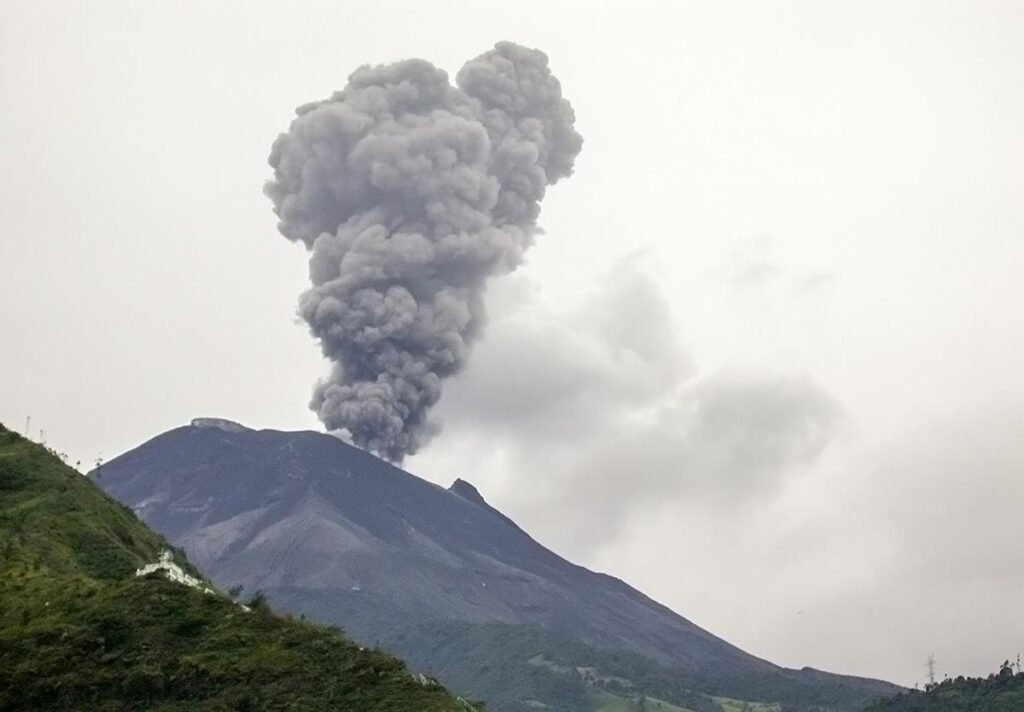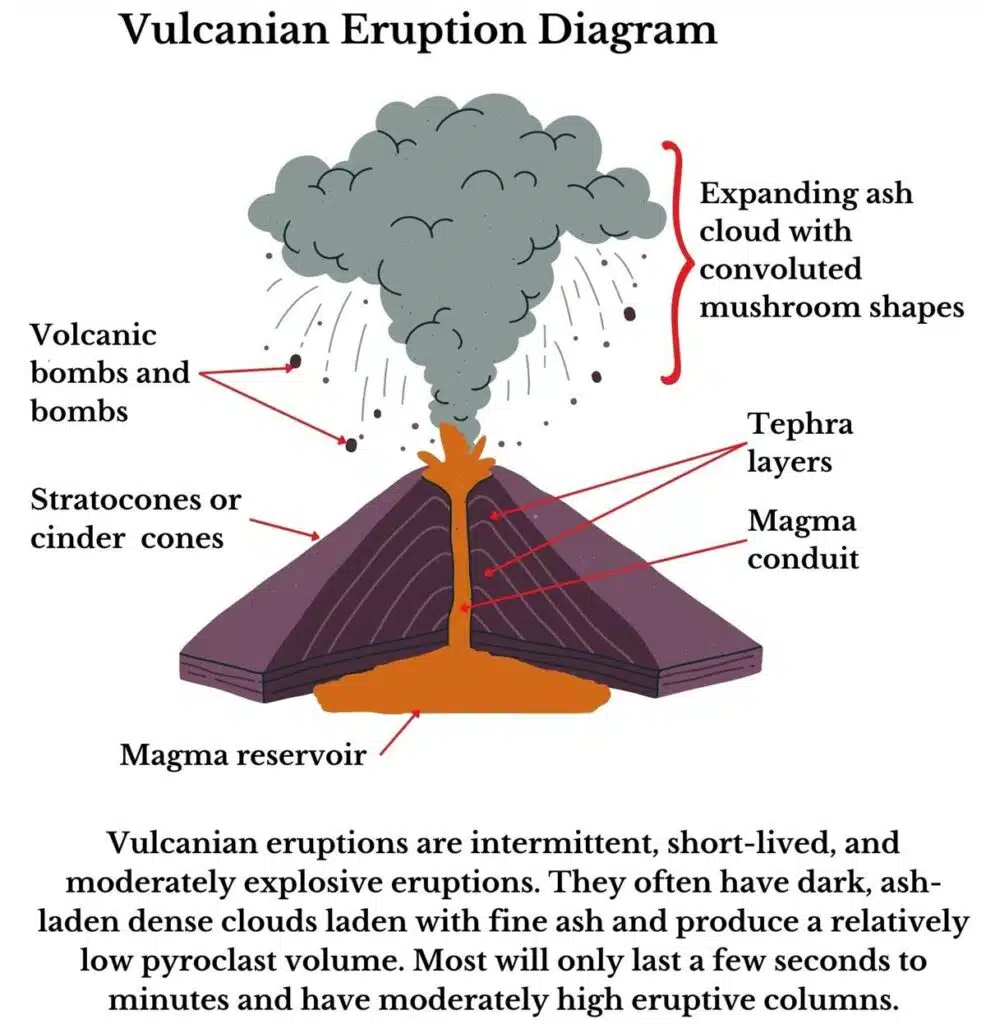Vulcanian eruptions are moderately explosive eruptions characterized by intermittent, short-lived explosions of ash-laden, convoluting dense clouds rising high above vents or craters.
Their explosivity index is 3-4 out of 8 based on eruption intensity and magnitude, and their eruptive plumes or columns reach moderate heights of 5-10 km above the earth’s surface. Their magnitude and intensity are higher than Strombolian eruptions but lower than Plinian eruptions.
Typical explosions are vigorous, produce a relatively small amount of pyroclast, about 102-106 tons, and last for seconds to minutes.
Some of these eruptions may possess phreatic or phreatomagmatic elements, if either the magma or hot rocks interacts with water.
Finally, Vulcanian eruptions are named after Vulcano Island, a volcanic island in the Italian Aeolian Archipelago arc in the southern Tyrrhenian Sea. Giuseppe Mercalli, an Italian priest, and volcanologists coined the name ‘Vulcanian’ after observing Fossa cone erupt at Vulcano Island.

Magma composition
Vulcanian eruptions commonly occur in intermediate magmas such as andesite or basalt andesite with at least 55% silica. Such magmas are moderate in viscosity, favoring this eruption style. However, other magmas like dacite, trachyte, trachyte-andesite, and sometimes rhyolite also produce these eruptions.
Vulcanian eruption description with diagram
Some of the characteristics that describe Vulcanian eruptions include the following:

1. Short-lived and erupt sporadically with loud bangs
Vulcanian eruptions are intermittent or sporadic, short-lived, and moderately explosive, with a volcanic explosivity index of 3-4.
These episodic eruptions are transient, lasting seconds to minutes, and will halt once the magma in the conduit erupts after blowing off the plug. Each episode occurs as a single, discrete, far-spaced event.
These eruptions commence with canon-like loud bangs, followed by an interval of irregular jets of gas and pyroclasts.
2. They produced dense plumes that go moderately high
Volcanian eruptions produce moderately high eruptive columns, usually 5–10 km above the earth’s surface. Sometimes, these eruptive columns can go higher, but they don’t reach the stratosphere.
As they erupt, they will produce an underexpanded gas-pyroclast mixture at supersonic speeds of up to 400 m/s. These ash-laden mixtures will incorporate air as they turbulently expand and rise, forming cauliflower or mushroom-like convoluted shapes.
Near the vents, Vulcanian eruptions will produce jets of black, dark, or dirty-gray ash-laden plumes, which will become lighter, i.e., cream or light gray clouds as they rise. These clouds become lighter as they incorporate more air, and some pyroclasts fall off.
The larger ballistics, like blocks and bombs, are not entrained into convectively rising ash clouds but will instead follow canon-like trajectories.
3. Involve small magma volumes
Vulcanian eruptions involve a small amount of magma, producing 102–106 tons of pyroclast. Only the plug material on the volcano’s neck and the magma present in the conduit erupt.
Repeated eruption can, however, result in larger cumulative amounts of deposited pyroclasts.
4. May have phreatic and phreatomagmatic components
Vulcanian eruptions may sometimes involve phreatic and phreatomagmatic components, which can help unclog the plug. A classic example is Halemaumau in Hawaii in 1924, where phreatic/phreatomagmatic elements were involved.
5. Pyroclasts vesicularity varies
Vulcanian eruptions produce mostly volcanic ash and smaller amounts of other pyroclasts such as lapilli, block, scoria, pumice, and volcanic bombs, including bread crust bombs.
These pyroclasts often have cognate, lithic, and juvenile fragments. Some pyroclasts contain up to 50% lithic fragments formed from the plug material.
Vulcanian eruptions produce finer fragments compared to other magmatic eruptions of similar volumes and dispersion areas. These fragments are finer due to the high energy involved during rapid decompression.
Juvenile fragments are also less vesicular and have thicker walls. Vesicularity of pyroclasts will also vary depending on how deep the erupted magma was in the conduit.
6. May transition
It is possible for Vulcanian eruptions to transition to Strombolian or Plinian, and vice versa. For instance, the Pacaya volcano in Guatemala and the Tungurahua volcano transitioned from Strombolian to Vulcanian.
How do Vulcanian eruptions form?
Vulcanian eruptions occur when vesicular magma containing exsolved gases and crystals under pressure suddenly breaches a constraining plug of solid or semi-solid magma, dome, or country rock.
This breaching or disruption will cause a sudden decompression, blasting the plug material and magma into the air at sonic to supersonic speeds.
Vulcanian eruptions form when slow-rising, viscous magma degasses, forming a solid or semi-solid plug. This plug or cap will prevent the escape of gases, causing pressure to build up beneath it. It is also possible for magma to intrude and build up pressure beneath a country rock plug.
The gradual pressure buildup will at some point disrupt the constraining cap, ejecting a pyroclast-gas mixture. These pyroclasts are from magma, and lithic plug materials include ash, pumice, blocks, and bombs.
Immediately after breaching the plug, these eruptions will produce dirty gray or black pyroclast plumes dominated by the plug material. As the eruption progresses, there will be cream-white or light gray ash-laden plumes, dominated by vesiculated juvenile material.
Once all the vesiculated magma in the conduit erupts, the Vulcanian eruption comes to a halt. The remaining depressurized and degassed magma may continue rising slowly, forming a new plug.
Vulcanian eruptions can, sometimes, form lahars, lava flows, and pyroclastic density currents (PDCs).
For instance, lahars form when deposited tephra interacts with water or ice, while the collapse of domes or eruptive columns may create PDCs. Lava flows, on the other hand, result from degassed magmas commonly produced towards the end of eruptions.
Some of the edifices formed by Vulcanian eruptions are scoria cones, domes, composite cones, and less often craters. Future eruptions can also destroy these volcanic structures.
Deposits
Vulcanian eruptions will deposit moderately sorted or well-sorted tephra, covering larger areas than Strombolian types and smaller than Plinian eruptions.
Since they are episodic, these eruptions will form stratified, relatively thin beds of fine ash, but some ash beds are as thick as one kilometer. This eruption will also deposit lapilli, blocks, and bombs, including bread crust bombs.
The deposited bombs and blocks can be as large as 2-3 meters. The larger blocks or bombs will fall a few hundreds of meters from the vent. Bombs or blocks about a half-meter can go up to 3 km away from the vent, while smaller ones will reach up to 6 km from the main vent.
Vulcanian eruption examples
These eruptions occur worldwide in geodynamic settings where intermediate magma erupts.
Common examples of Vulcanian eruptions in the US are Mt. Redoubt in Alaska (March 2009), Lessen Volcanic Park in California (1915), and Trident Volcano in Alaska (1953 and 1974).
Examples elsewhere are Sakurajima and Asamayama in Japan, Semeru Volcano in Indonesia, Fuego Volcano in Guatemala, and Manan in Papua New Guinea.
Others are the Soufrière Hills volcano in Montserrat (1997), Mt. Unzen Volcano in Japan (1990s), Ngauruhoe volcano in New Zealand (1975), Mt. Stromboli (09/11/1930), and Irazú in Costa Rica (1936, 1965).
Are Vulcanian eruptions dangerous?
Yes, Vulcanian eruptions are dangerous to observers and communities that live near their vents or downslope.
These eruptions can deposit huge volumes of tephra, which will bury houses, roads, farmlands, or other infrastructure. Additionally, they can spew ballistic blocks or bombs that can hit onlookers or tumble downslope, causing injuries, deaths, and property destruction.
That is not all. Vulcanian eruptions can precede the deadlier Plinian eruption. They can also cause dangerous pyroclastic density currents due to the collapse of eruptive columns or domes.
For instance, during the Galeras eruptions in Colombia, volcanic bombs struck and killed vulcanologists. The Soufrière Hills, on the other hand, produced pyroclastic density currents in August to October 1997.
Some moderately explosive Vulcanian eruptions are, however, safe to watch. An example is the Irazú volcano eruption in 1962 and 1965 that attracted locals with steam streams from the ground and sulfurous mud baths. Other relatively safe eruptions to watch are Manan and Sakurajima.
